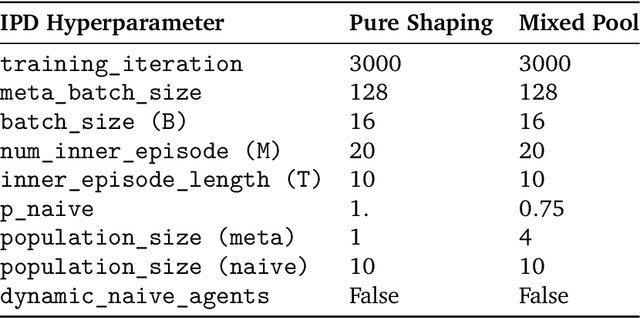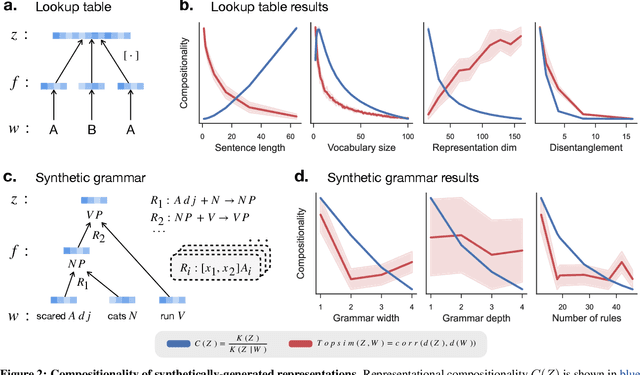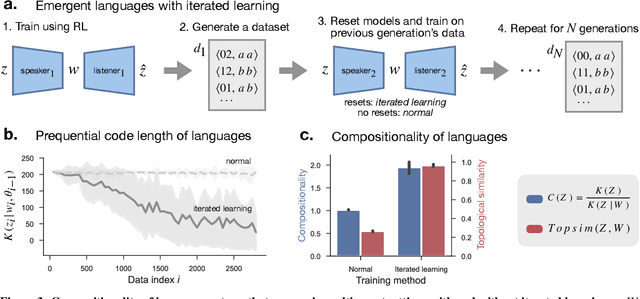Guillaume Lajoie
Université de Montréal, Mila - Quebec Artificial Intelligence Institute
Emergent temporal abstractions in autoregressive models enable hierarchical reinforcement learning
Dec 24, 2025Abstract:Large-scale autoregressive models pretrained on next-token prediction and finetuned with reinforcement learning (RL) have achieved unprecedented success on many problem domains. During RL, these models explore by generating new outputs, one token at a time. However, sampling actions token-by-token can result in highly inefficient learning, particularly when rewards are sparse. Here, we show that it is possible to overcome this problem by acting and exploring within the internal representations of an autoregressive model. Specifically, to discover temporally-abstract actions, we introduce a higher-order, non-causal sequence model whose outputs control the residual stream activations of a base autoregressive model. On grid world and MuJoCo-based tasks with hierarchical structure, we find that the higher-order model learns to compress long activation sequence chunks onto internal controllers. Critically, each controller executes a sequence of behaviorally meaningful actions that unfold over long timescales and are accompanied with a learned termination condition, such that composing multiple controllers over time leads to efficient exploration on novel tasks. We show that direct internal controller reinforcement, a process we term "internal RL", enables learning from sparse rewards in cases where standard RL finetuning fails. Our results demonstrate the benefits of latent action generation and reinforcement in autoregressive models, suggesting internal RL as a promising avenue for realizing hierarchical RL within foundation models.
Recursive Self-Aggregation Unlocks Deep Thinking in Large Language Models
Sep 30, 2025Abstract:Test-time scaling methods improve the capabilities of large language models (LLMs) by increasing the amount of compute used during inference to make a prediction. Inference-time compute can be scaled in parallel by choosing among multiple independent solutions or sequentially through self-refinement. We propose Recursive Self-Aggregation (RSA), a test-time scaling method inspired by evolutionary methods that combines the benefits of both parallel and sequential scaling. Each step of RSA refines a population of candidate reasoning chains through aggregation of subsets to yield a population of improved solutions, which are then used as the candidate pool for the next iteration. RSA exploits the rich information embedded in the reasoning chains -- not just the final answers -- and enables bootstrapping from partially correct intermediate steps within different chains of thought. Empirically, RSA delivers substantial performance gains with increasing compute budgets across diverse tasks, model families and sizes. Notably, RSA enables Qwen3-4B-Instruct-2507 to achieve competitive performance with larger reasoning models, including DeepSeek-R1 and o3-mini (high), while outperforming purely parallel and sequential scaling strategies across AIME-25, HMMT-25, Reasoning Gym, LiveCodeBench-v6, and SuperGPQA. We further demonstrate that training the model to combine solutions via a novel aggregation-aware reinforcement learning approach yields significant performance gains. Code available at https://github.com/HyperPotatoNeo/RSA.
MesaNet: Sequence Modeling by Locally Optimal Test-Time Training
Jun 05, 2025Abstract:Sequence modeling is currently dominated by causal transformer architectures that use softmax self-attention. Although widely adopted, transformers require scaling memory and compute linearly during inference. A recent stream of work linearized the softmax operation, resulting in powerful recurrent neural network (RNN) models with constant memory and compute costs such as DeltaNet, Mamba or xLSTM. These models can be unified by noting that their recurrent layer dynamics can all be derived from an in-context regression objective, approximately optimized through an online learning rule. Here, we join this line of work and introduce a numerically stable, chunkwise parallelizable version of the recently proposed Mesa layer (von Oswald et al., 2024), and study it in language modeling at the billion-parameter scale. This layer again stems from an in-context loss, but which is now minimized to optimality at every time point using a fast conjugate gradient solver. Through an extensive suite of experiments, we show that optimal test-time training enables reaching lower language modeling perplexity and higher downstream benchmark performance than previous RNNs, especially on tasks requiring long context understanding. This performance gain comes at the cost of additional flops spent during inference time. Our results are therefore intriguingly related to recent trends of increasing test-time compute to improve performance -- here by spending compute to solve sequential optimization problems within the neural network itself.
Generalizable, real-time neural decoding with hybrid state-space models
Jun 05, 2025Abstract:Real-time decoding of neural activity is central to neuroscience and neurotechnology applications, from closed-loop experiments to brain-computer interfaces, where models are subject to strict latency constraints. Traditional methods, including simple recurrent neural networks, are fast and lightweight but often struggle to generalize to unseen data. In contrast, recent Transformer-based approaches leverage large-scale pretraining for strong generalization performance, but typically have much larger computational requirements and are not always suitable for low-resource or real-time settings. To address these shortcomings, we present POSSM, a novel hybrid architecture that combines individual spike tokenization via a cross-attention module with a recurrent state-space model (SSM) backbone to enable (1) fast and causal online prediction on neural activity and (2) efficient generalization to new sessions, individuals, and tasks through multi-dataset pretraining. We evaluate POSSM's decoding performance and inference speed on intracortical decoding of monkey motor tasks, and show that it extends to clinical applications, namely handwriting and speech decoding in human subjects. Notably, we demonstrate that pretraining on monkey motor-cortical recordings improves decoding performance on the human handwriting task, highlighting the exciting potential for cross-species transfer. In all of these tasks, we find that POSSM achieves decoding accuracy comparable to state-of-the-art Transformers, at a fraction of the inference cost (up to 9x faster on GPU). These results suggest that hybrid SSMs are a promising approach to bridging the gap between accuracy, inference speed, and generalization when training neural decoders for real-time, closed-loop applications.
Sufficient conditions for offline reactivation in recurrent neural networks
May 22, 2025Abstract:During periods of quiescence, such as sleep, neural activity in many brain circuits resembles that observed during periods of task engagement. However, the precise conditions under which task-optimized networks can autonomously reactivate the same network states responsible for online behavior is poorly understood. In this study, we develop a mathematical framework that outlines sufficient conditions for the emergence of neural reactivation in circuits that encode features of smoothly varying stimuli. We demonstrate mathematically that noisy recurrent networks optimized to track environmental state variables using change-based sensory information naturally develop denoising dynamics, which, in the absence of input, cause the network to revisit state configurations observed during periods of online activity. We validate our findings using numerical experiments on two canonical neuroscience tasks: spatial position estimation based on self-motion cues, and head direction estimation based on angular velocity cues. Overall, our work provides theoretical support for modeling offline reactivation as an emergent consequence of task optimization in noisy neural circuits.
* ICLR 2024
Bidirectional Information Flow (BIF) -- A Sample Efficient Hierarchical Gaussian Process for Bayesian Optimization
May 16, 2025Abstract:Hierarchical Gaussian Process (H-GP) models divide problems into different subtasks, allowing for different models to address each part, making them well-suited for problems with inherent hierarchical structure. However, typical H-GP models do not fully take advantage of this structure, only sending information up or down the hierarchy. This one-way coupling limits sample efficiency and slows convergence. We propose Bidirectional Information Flow (BIF), an efficient H-GP framework that establishes bidirectional information exchange between parent and child models in H-GPs for online training. BIF retains the modular structure of hierarchical models - the parent combines subtask knowledge from children GPs - while introducing top-down feedback to continually refine children models during online learning. This mutual exchange improves sample efficiency, enables robust training, and allows modular reuse of learned subtask models. BIF outperforms conventional H-GP Bayesian Optimization methods, achieving up to 85% and 5x higher $R^2$ scores for the parent and children respectively, on synthetic and real-world neurostimulation optimization tasks.
In-Context Parametric Inference: Point or Distribution Estimators?
Feb 17, 2025Abstract:Bayesian and frequentist inference are two fundamental paradigms in statistical estimation. Bayesian methods treat hypotheses as random variables, incorporating priors and updating beliefs via Bayes' theorem, whereas frequentist methods assume fixed but unknown hypotheses, relying on estimators like maximum likelihood. While extensive research has compared these approaches, the frequentist paradigm of obtaining point estimates has become predominant in deep learning, as Bayesian inference is challenging due to the computational complexity and the approximation gap of posterior estimation methods. However, a good understanding of trade-offs between the two approaches is lacking in the regime of amortized estimators, where in-context learners are trained to estimate either point values via maximum likelihood or maximum a posteriori estimation, or full posteriors using normalizing flows, score-based diffusion samplers, or diagonal Gaussian approximations, conditioned on observations. To help resolve this, we conduct a rigorous comparative analysis spanning diverse problem settings, from linear models to shallow neural networks, with a robust evaluation framework assessing both in-distribution and out-of-distribution generalization on tractable tasks. Our experiments indicate that amortized point estimators generally outperform posterior inference, though the latter remain competitive in some low-dimensional problems, and we further discuss why this might be the case.
Amortized In-Context Bayesian Posterior Estimation
Feb 10, 2025Abstract:Bayesian inference provides a natural way of incorporating prior beliefs and assigning a probability measure to the space of hypotheses. Current solutions rely on iterative routines like Markov Chain Monte Carlo (MCMC) sampling and Variational Inference (VI), which need to be re-run whenever new observations are available. Amortization, through conditional estimation, is a viable strategy to alleviate such difficulties and has been the guiding principle behind simulation-based inference, neural processes and in-context methods using pre-trained models. In this work, we conduct a thorough comparative analysis of amortized in-context Bayesian posterior estimation methods from the lens of different optimization objectives and architectural choices. Such methods train an amortized estimator to perform posterior parameter inference by conditioning on a set of data examples passed as context to a sequence model such as a transformer. In contrast to language models, we leverage permutation invariant architectures as the true posterior is invariant to the ordering of context examples. Our empirical study includes generalization to out-of-distribution tasks, cases where the assumed underlying model is misspecified, and transfer from simulated to real problems. Subsequently, it highlights the superiority of the reverse KL estimator for predictive problems, especially when combined with the transformer architecture and normalizing flows.
Multi-agent cooperation through learning-aware policy gradients
Oct 24, 2024



Abstract:Self-interested individuals often fail to cooperate, posing a fundamental challenge for multi-agent learning. How can we achieve cooperation among self-interested, independent learning agents? Promising recent work has shown that in certain tasks cooperation can be established between learning-aware agents who model the learning dynamics of each other. Here, we present the first unbiased, higher-derivative-free policy gradient algorithm for learning-aware reinforcement learning, which takes into account that other agents are themselves learning through trial and error based on multiple noisy trials. We then leverage efficient sequence models to condition behavior on long observation histories that contain traces of the learning dynamics of other agents. Training long-context policies with our algorithm leads to cooperative behavior and high returns on standard social dilemmas, including a challenging environment where temporally-extended action coordination is required. Finally, we derive from the iterated prisoner's dilemma a novel explanation for how and when cooperation arises among self-interested learning-aware agents.
A Complexity-Based Theory of Compositionality
Oct 18, 2024



Abstract:Compositionality is believed to be fundamental to intelligence. In humans, it underlies the structure of thought, language, and higher-level reasoning. In AI, compositional representations can enable a powerful form of out-of-distribution generalization, in which a model systematically adapts to novel combinations of known concepts. However, while we have strong intuitions about what compositionality is, there currently exists no formal definition for it that is measurable and mathematical. Here, we propose such a definition, which we call representational compositionality, that accounts for and extends our intuitions about compositionality. The definition is conceptually simple, quantitative, grounded in algorithmic information theory, and applicable to any representation. Intuitively, representational compositionality states that a compositional representation satisfies three properties. First, it must be expressive. Second, it must be possible to re-describe the representation as a function of discrete symbolic sequences with re-combinable parts, analogous to sentences in natural language. Third, the function that relates these symbolic sequences to the representation, analogous to semantics in natural language, must be simple. Through experiments on both synthetic and real world data, we validate our definition of compositionality and show how it unifies disparate intuitions from across the literature in both AI and cognitive science. We also show that representational compositionality, while theoretically intractable, can be readily estimated using standard deep learning tools. Our definition has the potential to inspire the design of novel, theoretically-driven models that better capture the mechanisms of compositional thought.
 Add to Chrome
Add to Chrome Add to Firefox
Add to Firefox Add to Edge
Add to Edge